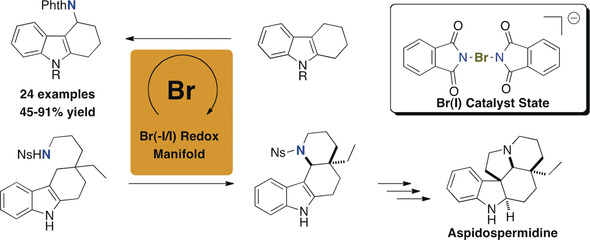Journal list menu
Export Citations
Download PDFs
Cover Pictures
Cover Picture: An Electrophilic Bromine Redox Catalysis for the Synthesis of Indole Alkaloid Building Blocks by Selective Aliphatic C−H Amination (Angew. Chem. Int. Ed. 48/2018)
- Page: 15609
- First Published: 12 November 2018
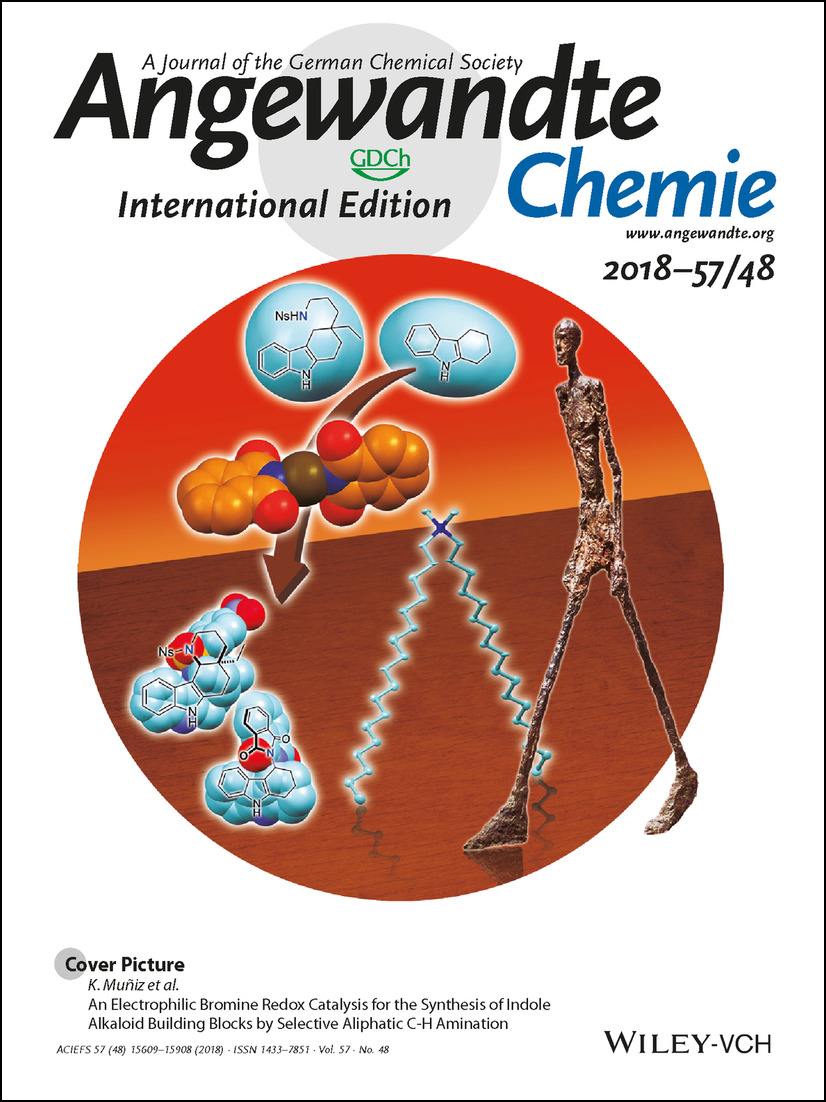
A giant step forward for bromine redox catalysis that enables intermolecular C−H amination reactions at previously inaccessible aliphatic positions is described by K. Muñiz et al. in their Communication on page 15891 ff. The approach is based on the formation of anionic bromine(I) catalysts by the stoichiometric oxidation of ammonium bromides with a bisphthalimidato iodine(III) oxidant. Crystal structures of the catalysts reveal the bulky ammonium counterions to have a shape that is comparable to Giacometti′s famous bronze sculpture L ′homme qui marche.
Inside Cover: Null Exciton Splitting in Chromophoric Greek Cross (+) Aggregate (Angew. Chem. Int. Ed. 48/2018)
- Page: 15610
- First Published: 12 November 2018
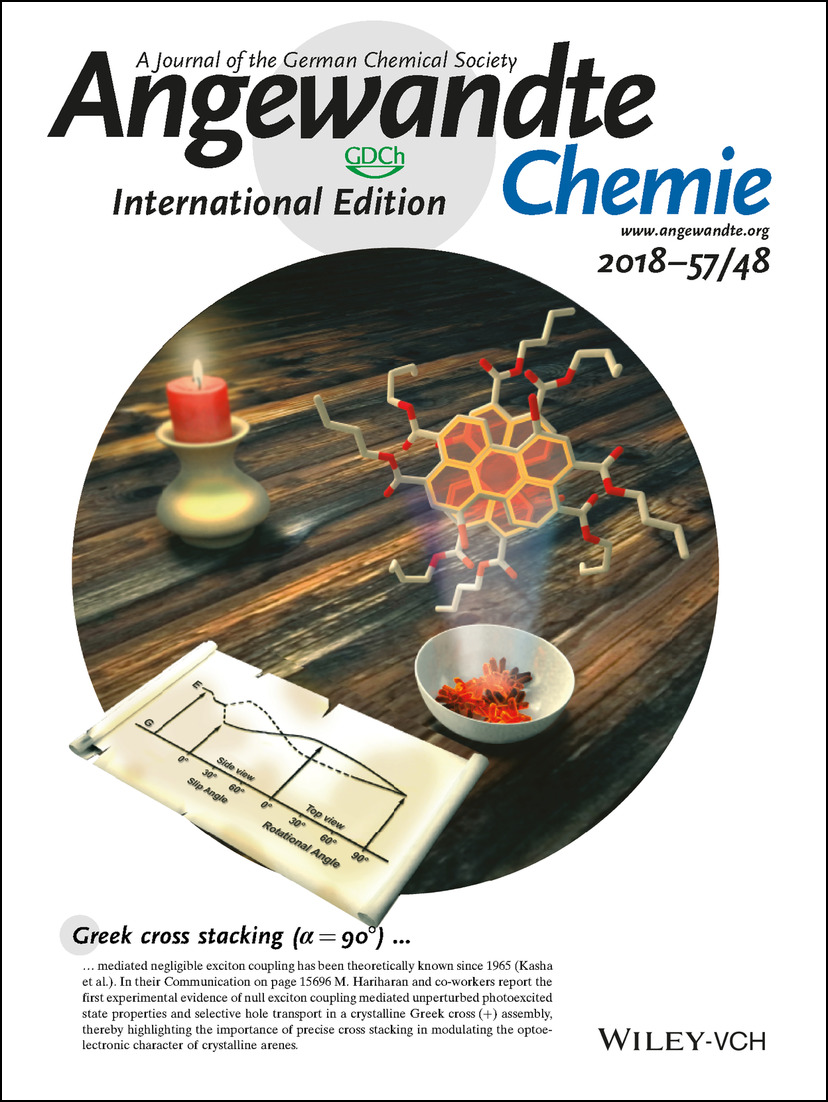
Greek cross stacking (α=90°) mediated negligible exciton coupling has been theoretically known since 1965 (Kasha et al.). In their Communication on page 15696 M. Hariharan and co-workers report the first experimental evidence of null exciton coupling mediated unperturbed photoexcited state properties and selective hole transport in a crystalline Greek cross (+) assembly, thereby highlighting the importance of precise cross stacking in modulating the optoelectronic character of crystalline arenes.
Inside Back Cover: Piezochromic Luminescence of Donor–Acceptor Cocrystals: Distinct Responses to Anisotropic Grinding and Isotropic Compression (Angew. Chem. Int. Ed. 48/2018)
- Page: 15907
- First Published: 05 November 2018
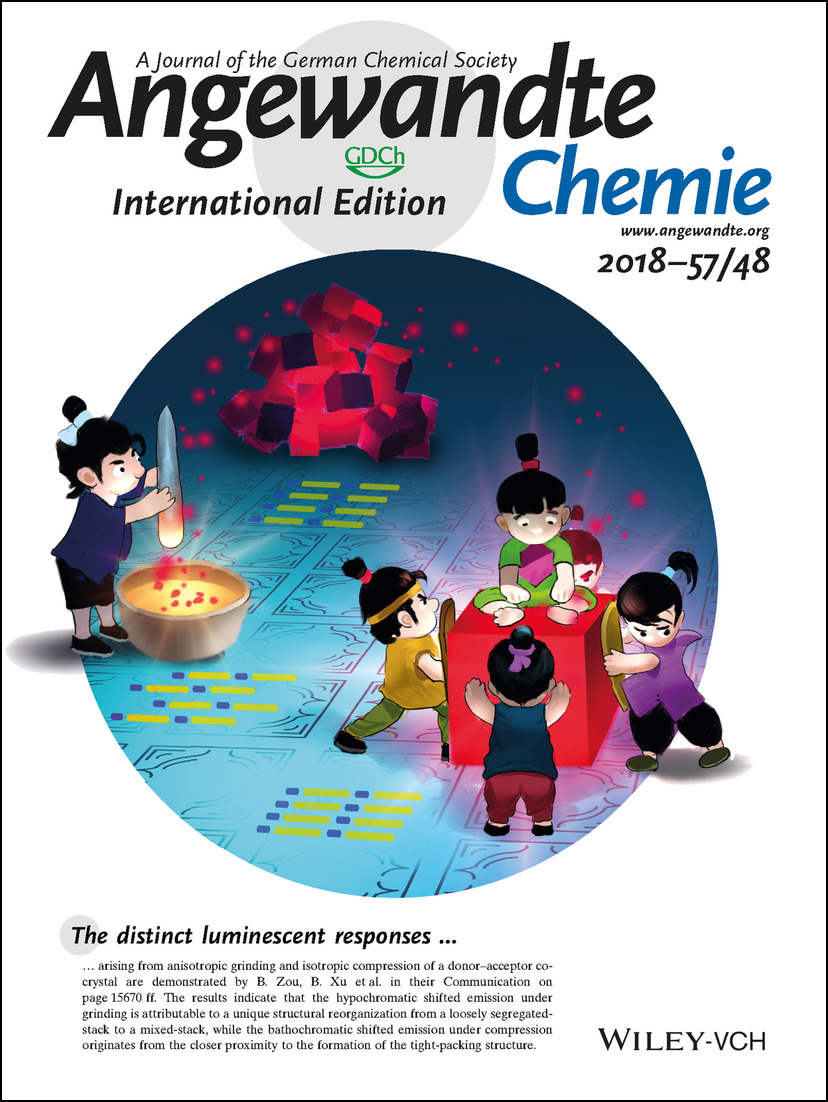
The distinct luminescent responses arising from anisotropic grinding and isotropic compression of a donor–acceptor co-crystal are demonstrated by B. Zou, B. Xu et al. in their Communication on page 15670 ff. The results indicate that the hypochromatic shifted emission under grinding is attributable to a unique structural reorganization from a loosely segregated-stack to a mixed-stack, while the bathochromatic shifted emission under compression originates from the closer proximity to the formation of the tight-packing structure.
Back Cover: Towards a Supertough Thermoplastic Polyisoprene Elastomer Based on a Biomimic Strategy (Angew. Chem. Int. Ed. 48/2018)
- Page: 15908
- First Published: 02 November 2018

Natural rubber is unique because its comprehensive mechanical performance is still unmatched by synthetic counterparts. Recyclability of vulcanized rubbers is also a major issue. As described by Y.-X. Xu, G. Huang et al. in their Communication on page 15836 ff., a tough thermoplastic polyisoprene, inspired by natural rubber, was synthesized by introducing terminal polar groups. Tetra-alanine is used as the crosslinking unit, which is derived from the hard segment of spider silk.
Frontispiece
Frontispiece: Hydrogen Atom Transfer Reactions via Photoredox Catalyzed Chlorine Atom Generation
- First Published: 20 November 2018
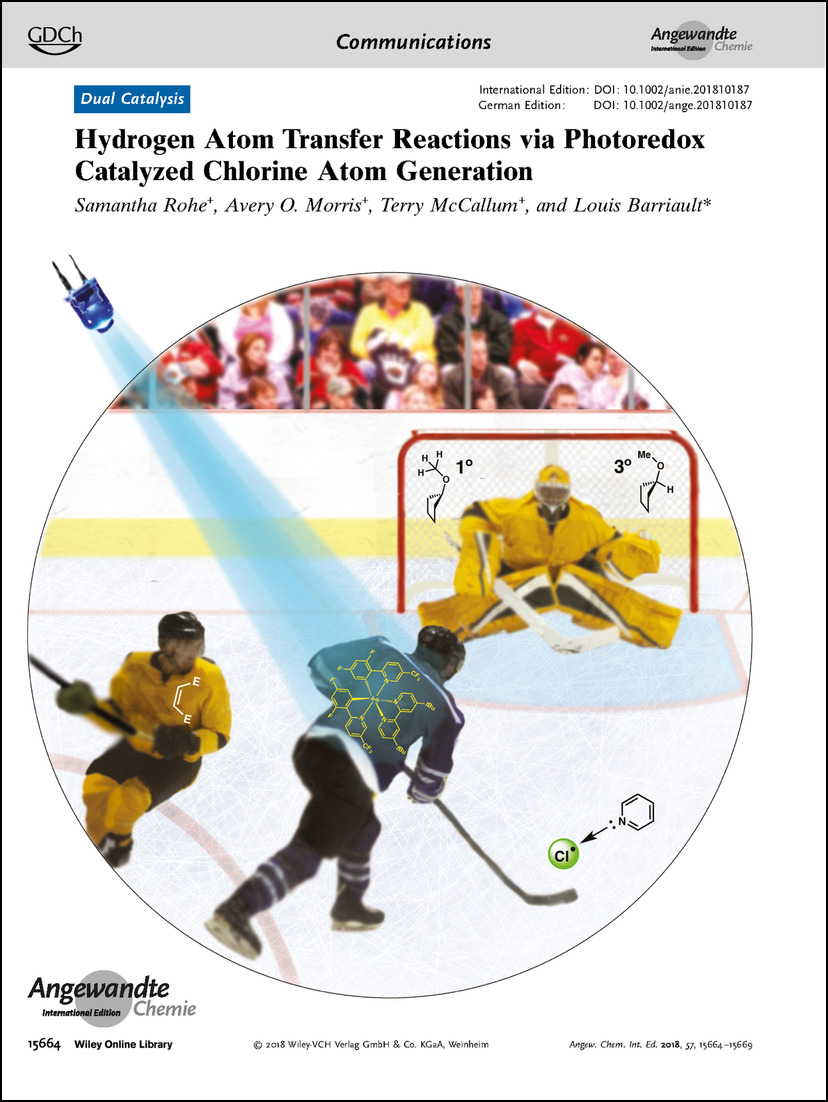
Photoredox Catalysis. Highly reactive chlorine atoms for C−H functionalizations are generated by L. Barriault and co-workers in their Communication on page 15664 through reductive quenching of *[Ir(dF(CF3)ppy)2(dtbbpy)]+ with chloride.
Guest Editorial
Empowering Students to Innovate: Engagement in Organic Chemistry Teaching
- Pages: 15612-15613
- First Published: 05 September 2018
Graphical Abstract
Graphical Abstract: Angew. Chem. Int. Ed. 48/2018
- Pages: 15615-15631
- First Published: 20 November 2018
Corrigenda
Corrigendum: Barium as Honorary Transition Metal in Action: Experimental and Theoretical Study of Ba(CO)+ and Ba(CO)−
- Pages: 15630-15631
- First Published: 08 October 2018
News
Spotlights on our sister journals: Angew. Chem. Int. Ed. 48/2018
- Pages: 15632-15636
- First Published: 20 November 2018
Author Profile
News
Real Sociedad Española de Química Prizes 2018
- Pages: 15639-15640
- First Published: 31 October 2018
Highlights
Magnetic Properties
From Laboratory Press to Spins with Giant Effects
- Pages: 15642-15644
- First Published: 31 October 2018
Reviews
Aerogels
Emerging Carbon-Nanofiber Aerogels: Chemosynthesis versus Biosynthesis
- Pages: 15646-15662
- First Published: 16 May 2018
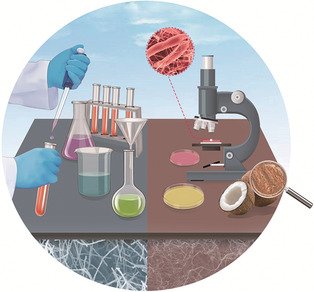
Aero smiths: Carbon aerogels exhibit many fascinating physical properties and great application potentials in widespread fields. This Review covers recent advances in synthetic strategies, physical properties, and multifunctional applications of two emerging carbon-nanofiber aerogels derived from chemosynthesis and biosynthesis approaches in a comparative perspective.
Communications
Dual Catalysis
Hydrogen Atom Transfer Reactions via Photoredox Catalyzed Chlorine Atom Generation
- Pages: 15664-15669
- First Published: 08 October 2018

A HAT trick: The generation of highly reactive chlorine atoms through photoredox mediated reductive quenching of *[Ir(dF(CF3)ppy)2(dtbbpy)]+ with chloride is reported. The C−H functionalization of a variety of alkanes, alcohols, ethers, ester, amides, aldehydes, and silanes through hydrogen atom transfer (HAT) processes with chlorine atoms underwent efficient redox-neutral coupling reactions with activated alkenes.
Luminescent Materials
Piezochromic Luminescence of Donor–Acceptor Cocrystals: Distinct Responses to Anisotropic Grinding and Isotropic Compression
- Pages: 15670-15674
- First Published: 23 September 2018
Bioanalytical Chemistry
A Single Extracellular Vesicle (EV) Flow Cytometry Approach to Reveal EV Heterogeneity
- Pages: 15675-15680
- First Published: 06 October 2018
Molecular Electronics
Two-Terminal Molecular Memory through Reversible Switching of Quantum Interference Features in Tunneling Junctions
- Pages: 15681-15685
- First Published: 27 September 2018
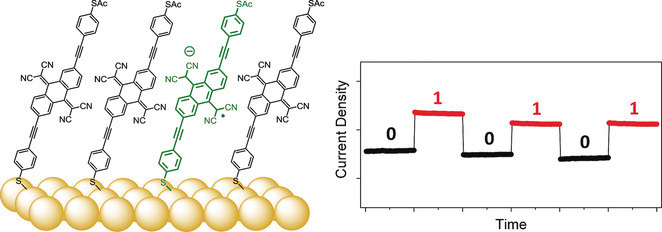
Memorable switching: A mixed monolayer comprising cross- and linearly conjugated molecules exhibited high conductance. When the linearly conjugated species were reversibly oxidized back to cross-conjugated species, destructive quantum interference was restored, and the conductance dropped, causing a memory effect (see picture).
Analytical Methods
Surface-Enhanced Raman Spectroscopy for the Detection of a Metabolic Product in the Headspace Above Live Bacterial Cultures
- Pages: 15686-15690
- First Published: 05 October 2018
Boron Chemistry
Facile Activation of Homoatomic σ Bonds in White Phosphorus and Diborane by a Diboraallene
- Pages: 15691-15695
- First Published: 09 October 2018

Metal-free activation of homoatomic E−E σ bonds (E=P, B) in white phosphorus (P4) and bis(catecholato)diboron (B2cat2) with a 1,2-diboraallene is reported. The former affords BnP4 cages (n=2, 4), whereas the latter leads to the formation of a tetraborane featuring a B4 chain through homonuclear catenation.
Exciton Interaction
Null Exciton Splitting in Chromophoric Greek Cross (+) Aggregate
- Pages: 15696-15701
- First Published: 19 October 2018
Bioimaging
Red-Shifted Fluorogenic Substrate for Detection of lacZ-Positive Cells in Living Tissue with Single-Cell Resolution
- Pages: 15702-15706
- First Published: 25 September 2018

SPiDER and the fly: A new fluorogenic β-galactosidase substrate, SPiDER-Red-βGal, based on a silicon rhodol scaffold and a carboxylic group as the intramolecular nucleophile, exhibited simultaneous activation of red fluorescence and labeling ability for intracellular proteins via a quinone methide intermediate. The probe can label lacZ-positive cells at single-cell resolution in vivo with perfect orthogonality to green fluorescent protein (GFP) markers.
Nanostructures
Direct Synthesis and Pseudomorphic Transformation of Mixed Metal Oxide Nanostructures with Non-Close-Packed Hollow Sphere Arrays
- Pages: 15707-15711
- First Published: 18 October 2018
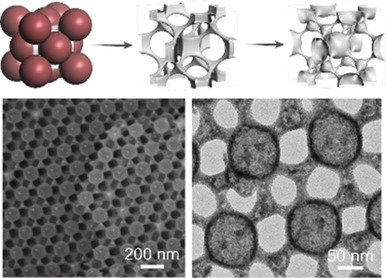
Airy architecture: A new concept for the fabrication of nanostructures featuring 3D ordered, non-close-packed hollow sphere arrays is demonstrated through controlling dynamic changes in interfacial properties between template and precursor. The polymeric colloidal crystal provides defined confinement through its tetrahedral and octahedral voids where the arrays are formed as a result of a crystallization-induced rearrangement.
Protein Modifications
Chemoproteomic Profiling of Phosphoaspartate Modifications in Prokaryotes
- Pages: 15712-15716
- First Published: 19 September 2018
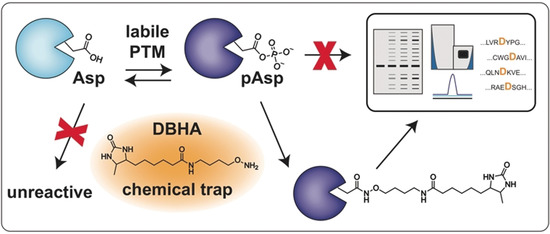
Phosphoaspartate modifications: A desthiobiotin-containing hydroxylamine (DBHA) chemical probe covalently labels modified aspartic acid residues in native proteomes. Coupled with isotopic labelling, DBHA-dependent proteomic profiling enables global quantification of changes in phosphoaspartate modification levels and protein levels.
Iron Complexes
Observation of Carbodicarbene Ligand Redox Noninnocence in Highly Oxidized Iron Complexes
- Pages: 15717-15722
- First Published: 21 September 2018
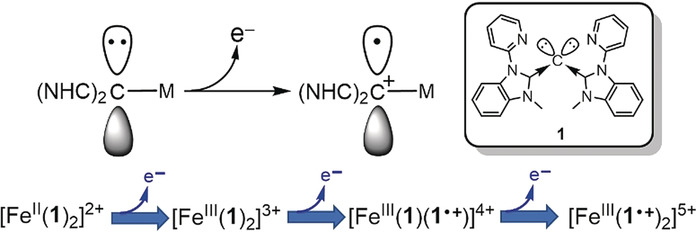
Carbones contain C atoms possessing two lone pairs of electrons. Thus, along with σ-coordination to a metal ion, they have a further pair of electrons, rendering them capable of π-donation or geminal coordination to a second metal. Via formation of a [Fe(1)2]n+ (n=2–5) redox series, where 1 is a tridentate carbodicarbene ligand, it is shown that this second pair of electrons also allows them to be redox-active.
G-Quadruplexes
Mirror-Image Dependence: Targeting Enantiomeric G-Quadruplex DNA Using Triplex Metallohelices
- Pages: 15723-15727
- First Published: 11 October 2018

Mirror, mirror: Chiral recognition of DNA plays crucial roles in many DNA-relevant events. The binding of ten pairs of iron helical metallohelices to enantiomeric G-quadruplex DNA was screened. The results clearly show mirror-image dependence for the Δ- and Λ-enantiomers binding to d- and l-DNA, respectively.
Enzyme-Induced Polymerization
Polymerizing Like Mussels Do: Toward Synthetic Mussel Foot Proteins and Resistant Glues
- Pages: 15728-15732
- First Published: 24 September 2018
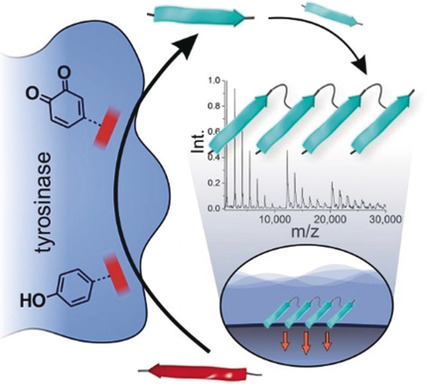
Mussel glue protein mimics: Adhesive mussel-inspired protein analogues were prepared by an enzyme-induced polymerization of oligopeptides. The polymers are generated by the formation of cysteinyldopa linkages that contribute to cohesion and adhesion of the protein analogues. Aspects of adhesion properties of mussel foot proteins were mimicked without the need to extract and purify or express native proteins.
Polymers | Very Important Paper
Predicting Monomers for Use in Polymerization-Induced Self-Assembly
- Pages: 15733-15737
- First Published: 19 October 2018
Protein Structures
PIP2 Phospholipid-Induced Aggregation of Tau Filaments Probed by Tip-Enhanced Raman Spectroscopy
- Pages: 15738-15742
- First Published: 02 October 2018
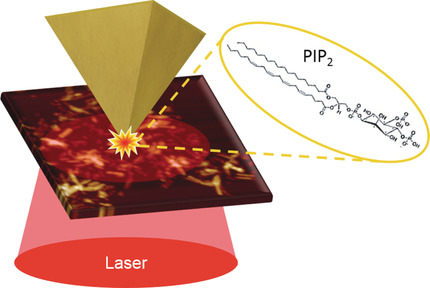
Tip of the iceberg: Tip-enhanced Raman spectroscopy reveals the inclusion of phosphatidylinositol (PIP2) phospholipid in tubulin-associated unit (Tau) filaments and provides an insight into protein secondary structure with nanoscale spatial resolution. Tau/phospholipid aggregates are implicated in deleterious mechanisms on neural membranes in Alzheimer's disease.
Lithium-Ion Batteries
Efficient Nanostructuring of Silicon by Electrochemical Alloying/Dealloying in Molten Salts for Improved Lithium Storage
- Pages: 15743-15748
- First Published: 10 October 2018

Bulk silicon can be nanostructured in a comparatively low-energy and environmentally benign approach of electrochemical Mg alloying/dealloying in molten salts at moderate temperatures. For lithium storage, the nanostructured Si exhibits a combination of high initial Coulombic efficiency, high specific capacity, and long cycling stability.
Polymers | Hot Paper
Supramolecular Electropolymerization
- Pages: 15749-15753
- First Published: 04 October 2018
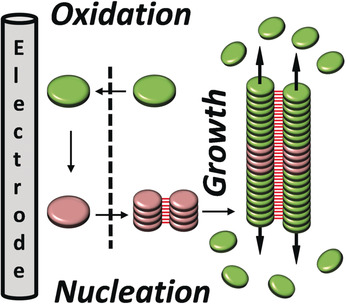
Trigger happy: The direct electrochemical oxidation of triarylamines at anodes triggers their nucleation and growth into supramolecular polymers. This mechanism can be defined as a supramolecular electropolymerization process. It is used to grow and precisely address single nanowires over a distance of 50 μm between two electrodes in a direct current electric field.
Colloids
Colloidal Molecules from Valence-Endowed Nanoparticles by Covalent Chemistry
- Pages: 15754-15757
- First Published: 11 October 2018
Polymer Brushes
Terraced and Smooth Gradient Polymer Brushes via a Polymer Single-Crystal Assisted Grafting-To Method
- Pages: 15758-15761
- First Published: 08 October 2018
C−H Activation
Amide Effects in C−H Activation: Noncovalent Interactions with L-Shaped Ligand for meta Borylation of Aromatic Amides
- Pages: 15762-15766
- First Published: 10 October 2018
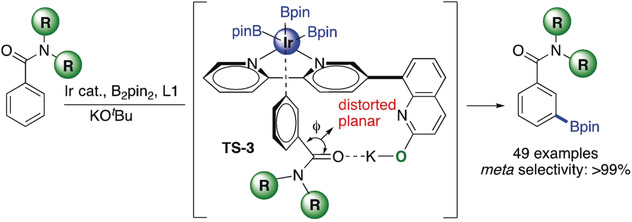
L-Shaped: A new concept for the meta borylation of aromatic amides is described. It has been shown that while esters give para borylations, amides result in meta borylations. For achieving high meta selectivity, an L-shaped ligand is used and engages in an O⋅⋅⋅K noncovalent interaction with the moderately distorted amide carbonyl group, providing exceptional control for meta C−H activation/borylation.
Supramolecular Chemistry
Homo- and Heteroligand Poly-NHC Metal Assemblies: Synthesis by Narcissistic and Social Self-Sorting
- Pages: 15767-15771
- First Published: 11 October 2018
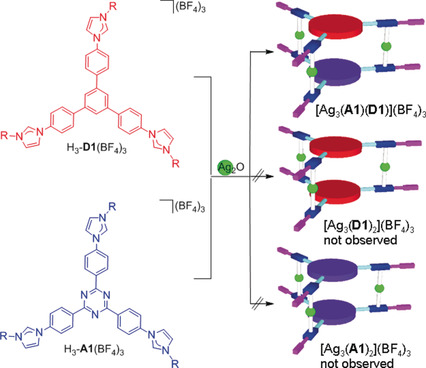
Unprecedented social self-sorting occurs during the reaction of Ag2O with two trisimidazolium salts featuring either an electron-poor H3-A1(BF4)3 or an electron-rich H3-D1(BF4)3 backbone to give the heteroligand assembly [Ag3(A1)(D1)](BF4)3 most likely driven by π⋅⋅⋅π stacking interactions between the electron-rich and electron-poor ligand backbone groups.
Soft Actuators | Hot Paper
An Anisotropic Hydrogel Actuator Enabling Earthworm-Like Directed Peristaltic Crawling
- Pages: 15772-15776
- First Published: 12 October 2018

Soft robot: An unprecedented photoresponsive hydrogel actuator enables earthworm-like peristaltic crawling and reverses its direction by scanning with a laser spotlight. This anomalous optical control was made possible by a rapid, large, repeatable, spatiotemporal, and anisotropic photothermal deformation of a hydrogel that contains gold nanoparticles in titanate nanosheets.
Crystalline Porous Material
All-Inorganic Ionic Porous Material Based on Giant Spherical Polyoxometalates Containing Core-Shell K6@K36-Water Cage
- Pages: 15777-15781
- First Published: 19 October 2018

Giant ionic cluster: The utilization of highly negative polyoxometalates for the clustering of alkali metal cations has allowed the synthesis of a rare all-inorganic ionic porous material built from novel giant ionic clusters {K42Ge8W72O272(H2O)60} (K42W72), which exhibits high proton conductivity. The K42W72 not only is among the largest ionic clusters but also contains unprecedented core–shell K6@K36-H2O cage.
Theranostics
The In Situ Sulfidation of Cu2O by Endogenous H2S for Colon Cancer Theranostics
- Pages: 15782-15786
- First Published: 11 October 2018
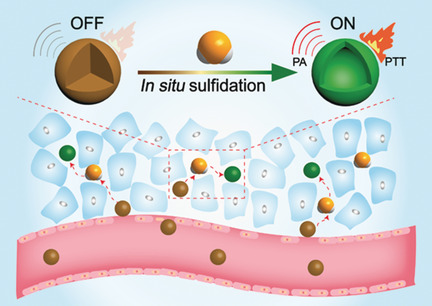
A turn-on theranostics agent was developed by utilizing the in situ reaction of Cu2O (see picture: brown) and endogenous H2S (yellow) at colon tumor sites. Based on in vitro and in vivo experiments, excellent photoacoustic imaging and photothermal therapy were both confirmed after being triggered by this in situ reaction. Cu9S8 shown in green.
Phosphine Catalysis
Phosphine-Catalyzed Difunctionalization of β-Fluoroalkyl α,β-Enones: A Direct Approach to β-Amino α-Diazo Carbonyl Compounds
- Pages: 15787-15791
- First Published: 07 October 2018

An efficient and practical phosphine-catalyzed vicinal difunctionalization of β-fluoroalkyl α,β-enones with TMSN3 has been developed. Meanwhile, the asymmetry variant induced by the nucleophilic bifunctional phosphine P4 led to various chiral fluoroalkylated β-amino α-diazocarbonyl compounds in high yields and enantioselectivity.
Electrocatalysis
Multifunctional Catalysts for H2O2-Resistant Hydrogen Fuel Cells
- Pages: 15792-15796
- First Published: 10 October 2018
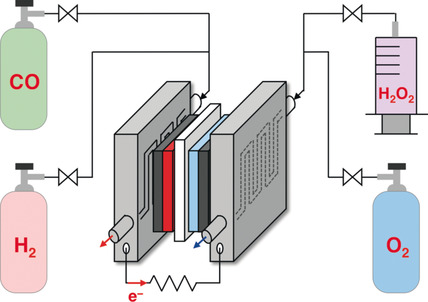
Peroxide allowed: The development of hydrogen fuel cells is greatly hindered by the unwanted generation of H2O2 at the cathode. A non-Pt cathode catalyst is now shown to be capable of simultaneously reducing both O2 and H2O2, thus rendering H2O2 a useful part of the feed stream. The applicability of this unique catalyst is demonstrated by employing it in a fuel cell running on H2/CO and O2/H2O2.
Supramolecular Chemistry
Platinum(II)-Based Supramolecular Scaffold-Templated Side-by-Side Assembly of Gold Nanorods through Pt⋅⋅⋅Pt and π–π Interactions
- Pages: 15797-15801
- First Published: 17 September 2018
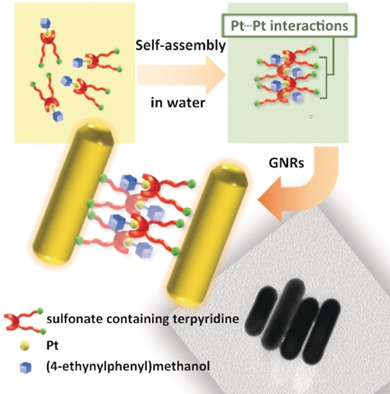
Side-by-side assembly: Supramolecular scaffold-templated side-by-side assembly of gold nanorods (GNRs) has been demonstrated by utilizing the sulfonate-containing alkynylplatinum(II) terpyridine complexes. Driven by non-covalent and directional Pt⋅⋅⋅Pt and π–π stacking interactions, the complexes show a high propensity to assemble in water with the plausible head-to-tail stacking arrangement to construct supramolecular scaffolds.
Phosphorus Chemistry
Photoelectrochemical Cells
A Water-Splitting Carbon Nitride Photoelectrochemical Cell with Efficient Charge Separation and Remarkably Low Onset Potential
- Pages: 15807-15811
- First Published: 16 October 2018
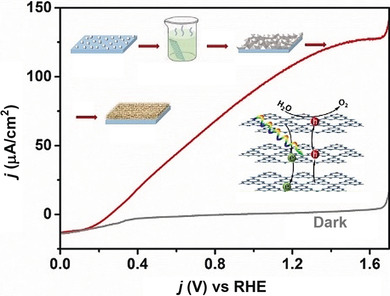
A simple and straightforward method is shown to grow a closely packed and porous CN layer directly on a conductive substrate as a photoanode, and it has excellent photoelectrochemical activity. The CN photoanode exhibits an exceptionally low onset potential, a high photocurrent density, an external quantum efficiency of 8.5 % at 400 nm, and good stability over a wide pH range.
Ammonia Synthesis
Single-Site Molybdenum on Solid Support Materials for Catalytic Hydrogenation of N2-into-NH3
- Pages: 15812-15816
- First Published: 11 October 2018
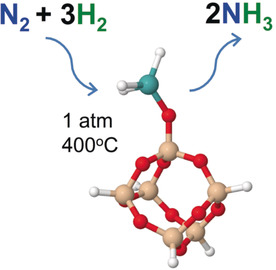
It'll be fixed in a Mo: N2-into-NH3 conversion is one of the most important processes in the chemical industry. A set of molybdenum on solid support materials catalyse N2 fixation under just atmospheric pressure and only 400 °C. They allow for an in-depth elucidation of the mechanistic events taking place which is supported by DFT analysis.
Data Storage Materials
Sequences of Sequences: Spatial Organization of Coded Matter through Layer-by-Layer Assembly of Digital Polymers
- Pages: 15817-15821
- First Published: 05 October 2018

Thin films containing segregated layers of digitally encoded polymers were prepared and characterized. An ASCII-encoded sentence of 160 bytes was stored in these films using a library of 16 different digital polyanions. The results show that abiotic coded matter can be organized in precise nanoscale morphologies.
Chemical Bonding | Very Important Paper
Unveiling the Sulfur–Sulfur Bridge: Accurate Structural and Energetic Characterization of a Homochalcogen Intermolecular Bond
- Pages: 15822-15826
- First Published: 10 October 2018
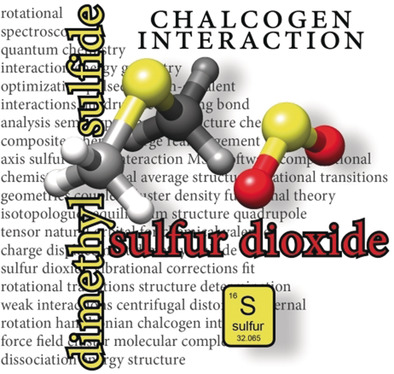
The noncovalent sulfur⋅⋅⋅sulfur interaction in the dimethyl sulfide–SO2 adduct has been investigated by combining rotational spectroscopy in supersonic expansion and quantum-chemical calculations and the first accurate semi-experimental equilibrium structure of this intermolecular adduct has been determined. A marked charge transfer takes place in the complex, whose stabilization energy thus is mainly determined by electrostatics and not by dispersion.
Supramolecular Chemistry
Diversity-Oriented Construction and Interconversion of Multicavity Supermacrocycles for Cooperative Anion–π Binding
- Pages: 15827-15831
- First Published: 08 October 2018
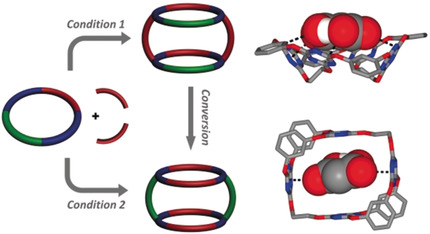
A one-pot strategy for the diversity-oriented construction of multicavity-containing supermacrocycles and their interconversion has been developed. With large cavities and multiple electron-deficient triazines, these supermacrocycles can accommodate large organic anions through unprecedented multiple anion–π interactions.
Cage Compounds
Radical-Mediated Thiol-Ene Strategy: Photoactivation of Thiol-Containing Drugs in Cancer Cells
- Pages: 15832-15835
- First Published: 09 October 2018
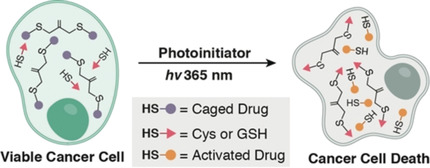
Rattling the cage: A UV-initiated thiol-ene reaction enables photoactivation-mediated decaging of isobutylene-caged thiols. With this strategy, the activity of the histone deacetylase inhibitor largazole can be switched off when stapled, but selectively switched on within cancer cells when irradiated with non-phototoxic light.
Synthetic Rubber
Towards a Supertough Thermoplastic Polyisoprene Elastomer Based on a Biomimic Strategy
- Pages: 15836-15840
- First Published: 21 October 2018
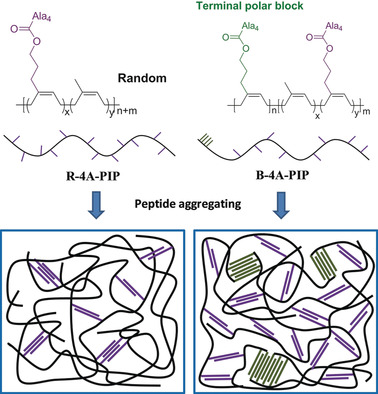
Terminal functionalization: Tetrapeptide grafting polyisoprenes were prepared with different sequences of polar groups. The terminal polar block promoted the toughness and stain-induced crystallization behavior of thermoplastic polyisoprene; these properties were comparable to vulcanized natural rubber.
Photochemistry
Visible-Light-Driven, Copper-Catalyzed Decarboxylative C(sp3)−H Alkylation of Glycine and Peptides
- Pages: 15841-15846
- First Published: 08 October 2018

Out of the clear blue: The title reaction was developed for preparing α-alkylated non-natural α-amino acids by transformation of glycine moieties. Mild conditions and good functional-group tolerance allow the modification of peptides using this method. Mechanistic studies revealed that a radical–radical coupling pathway is involved in the reaction.
Photoredox/Nickel-Catalyzed Single-Electron Tsuji–Trost Reaction: Development and Mechanistic Insights
- Pages: 15847-15851
- First Published: 11 October 2018

Coming to light: Report herein is a highly regioselective, intermolecular, nickel-catalyzed photoredox allylic substitution that expands both the radical and electrophile scope of dual photoredox/Ni-catalyzed reactions. Quantum mechanical calculations shed light on the mechanistic pathway, supporting a Ni0 to NiII oxidative addition followed by an inner-sphere radical addition. PC=photocatalyst, RP=radical precursor.
Cyclopropanation
Highly Diastereo- and Enantioselective Synthesis of Nitrile-Substituted Cyclopropanes by Myoglobin-Mediated Carbene Transfer Catalysis
- Pages: 15852-15856
- First Published: 09 October 2018
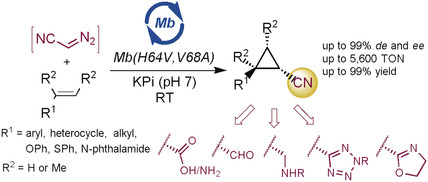
One for many: A chemobiocatalytic strategy involving myoglobin-catalyzed olefin cyclopropanation in the presence of ex situ generated diazoacetonitrile enables the efficient synthesis of a broad range of nitrile-substituted cyclopropanes with high diastereo- and enantioselectivity. The enzymatic product could be further elaborated to afford a variety of functionalized chiral cyclopropanes.
Synthetic Methods
Synthesis of BCP Benzylamines From 2-Azaallyl Anions and [1.1.1]Propellane
- Pages: 15857-15861
- First Published: 05 October 2018
Intramolecular Consecutive Dehydro-Diels–Alder Reaction for the Catalytic and Enantioselective Construction of Axial Chirality
- Pages: 15862-15865
- First Published: 05 November 2018
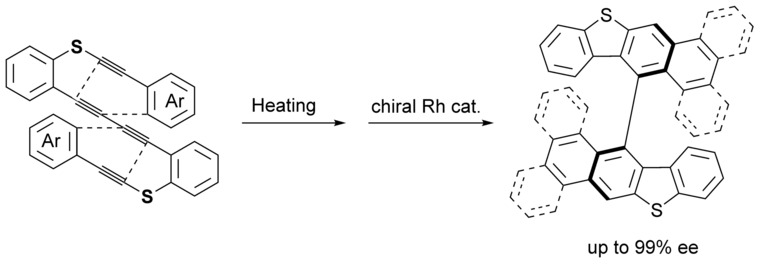
Going axial: A catalytic and enantioselective dehydro-Diels–Alder (DDA) reaction is described. Consecutive thermal and chiral-rhodium-catalyzed intramolecular reactions of sulfur-tethered tetraynes, with a 1,3-diyne moiety, proceeded to give doubly cyclized products, where axial chirality was achieved for the resulting dibenzothiophenyl moieties. This is a new strategy for the generation of axial chirality along with the formation of benzene rings.
Natural Products
Total Synthesis of Divergolides E and H
- Pages: 15866-15870
- First Published: 12 October 2018
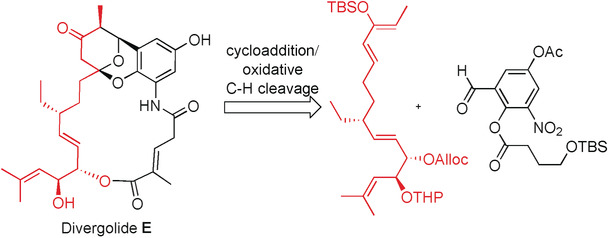
Family traits: The divergolides are a structurally disparate family of antibiotics that are synthesized by endophytes and isolated from mangroves off the Chinese coast. Reported here are the first syntheses of two members of the family that contain a bridged bicyclic acetal core. This unit was accessed by a telescoped sequence employing an asymmetric hetero-Diels–Alder reaction for fragment coupling and an oxidative carbon–hydrogen bond cleavage to enable acetal formation.
Alkene Difunctionalization
Palladium-Catalyzed Intermolecular Arylcarbonylation of Unactivated Alkenes: Incorporation of Bulky Aryl Groups at Room Temperature
- Pages: 15871-15876
- First Published: 08 October 2018

Bulking up: The bulky aryl group (ArL) of unsymmetrical diaryliodonium salts was exclusively incorporated at the α-position of unactivated terminal alkenes in a palladium-catalyzed intermolecular arylcarbonylation reaction (see scheme). The reaction occurs under very mild conditions and features excellent chemo- and regioselectivity and high functional-group tolerance.
Organocatalysis
Catalytic Enantioselective Aldol Reactions of Unprotected Carboxylic Acids under Phosphine Oxide Catalysis
- Pages: 15877-15881
- First Published: 08 October 2018
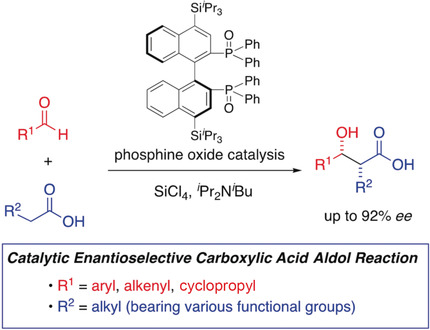
Various unprotected carboxylic acids undergo enantioselective aldol reactions in the presence of a chiral phosphine oxide as a Lewis base catalyst. The carboxylic acids were activated with silicon tetrachloride to form the bis(trichlorosilyl)enediolates in situ, which subsequently underwent an aldol reaction with an aldehyde or a ketone to produce β-hydroxycarboxylic acids in high enantioselectivities of up to 92 % ee.
Supramolecular Chemistry | Hot Paper
Quadruply Twisted Hückel-Aromatic Dodecaphyrin
- Pages: 15882-15886
- First Published: 15 October 2018
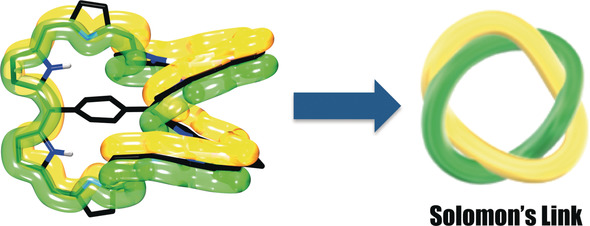
All in a twist: π-Conjugated macrocycles possessing a quadruply twisted topology were realized by conformational fixation using the insertion of a 1,4-phenylene bridge and PdII metalation. The syn-isomer of bis-PdII complexes displays aromatic character, and is thus identified as the first example of quadruply twisted Hückel aromatic molecule.
Biosynthesis
A Clade II-D Fungal Chimeric Diterpene Synthase from Colletotrichum gloeosporioides Produces Dolasta-1(15),8-diene
- Pages: 15887-15890
- First Published: 02 October 2018

The missing link: Fungal chimeric diterpene synthases with prenyltransferase and terpene synthase domains fall into two clades (I+II) with six subclades (A–F). The present study reports the characterization of the first clade II-D enzyme, the structures of its products, and the cyclization mechanism. The observed 12R configuration reveals a uniform stereochemistry at this carbon for all clade II enzyme products.
Homogeneous Catalysis
An Electrophilic Bromine Redox Catalysis for the Synthesis of Indole Alkaloid Building Blocks by Selective Aliphatic C−H Amination
- Pages: 15891-15895
- First Published: 04 October 2018
Low-Valent Compounds
Construction of Linear and Branched Tetraboranes by 1,1- and 1,2-Diboration of Diborenes
- Pages: 15896-15901
- First Published: 02 October 2018
Gas-Phase Reactions
Selective Nitrogen-Atom Transfer Driven by a Highly Efficient Intersystem Crossing in the [CeON]+/CH4 System
- Pages: 15902-15906
- First Published: 10 October 2018
![Selective Nitrogen-Atom Transfer Driven by a Highly Efficient Intersystem Crossing in the [CeON]+/CH4 System](/cms/asset/c67834a8-bb95-4938-b8d7-e67cdcb60c6d/anie201809583-toc-0001-m.jpg)
The one and only: Nitrogen-atom transfer from the cluster ion to methane was observed as the only reaction channel for thermal gas-phase reactions of [CeON]+ with methane. Based on computational work, the neutral molecule formed corresponds to either CH2NH2 or CH3NH. This reaction benefits from a rather weak OCe+−N bond and a highly efficient intersystem crossing.




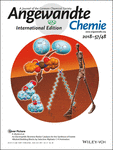

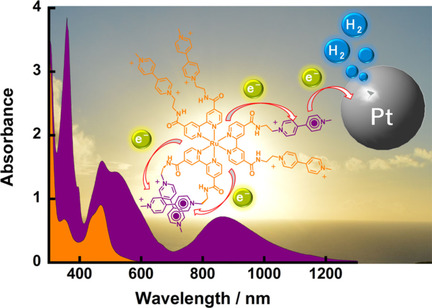



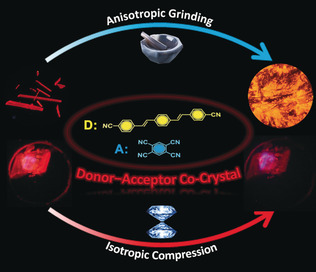
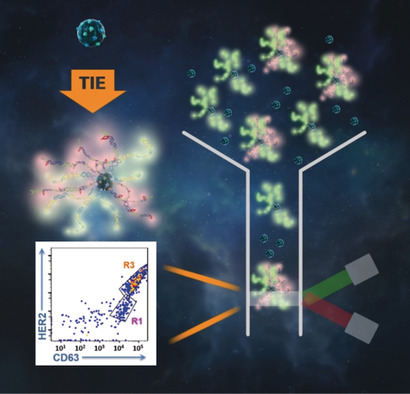
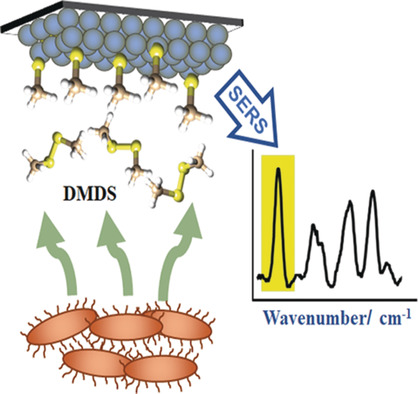
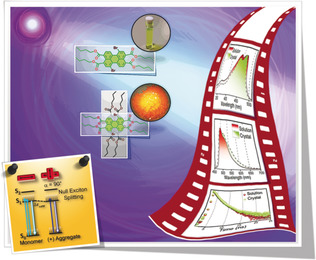
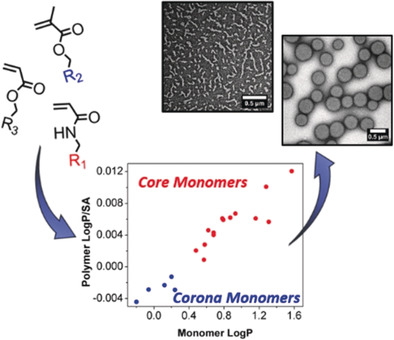
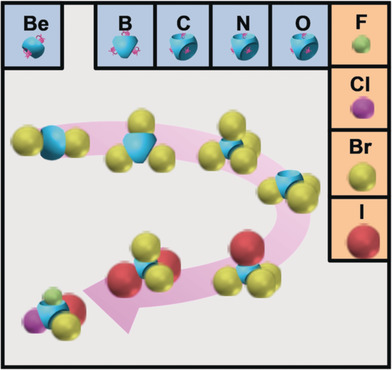
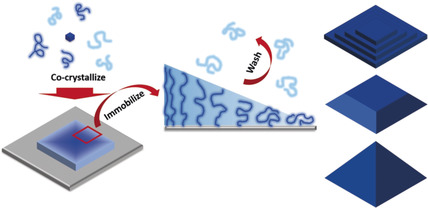
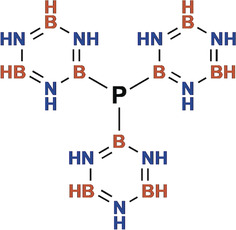
![Synthesis of BCP Benzylamines From 2-Azaallyl Anions and [1.1.1]Propellane](/cms/asset/85e203fe-ca2d-46fd-947a-816feee5a45c/anie201810061-toc-0001-m.jpg)
